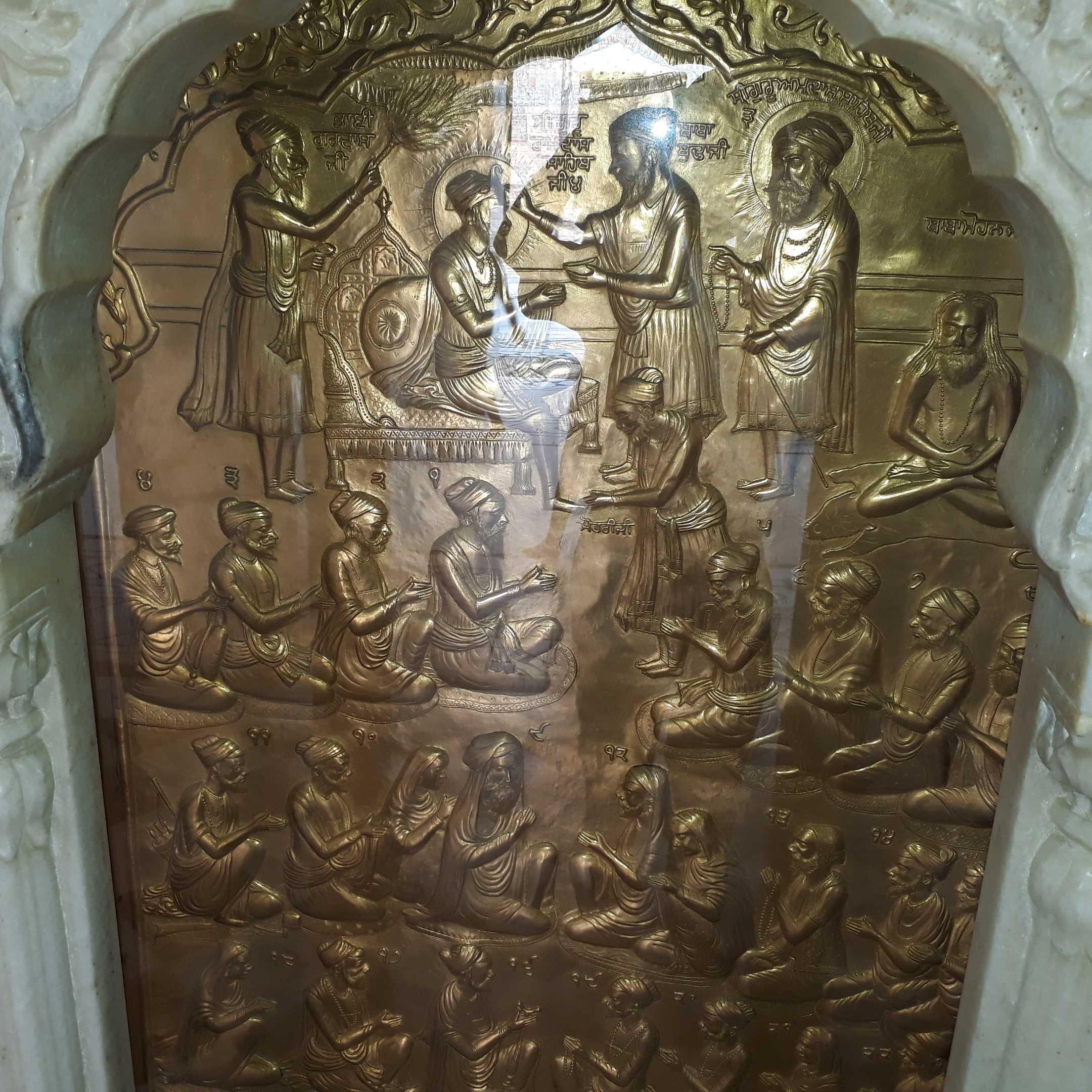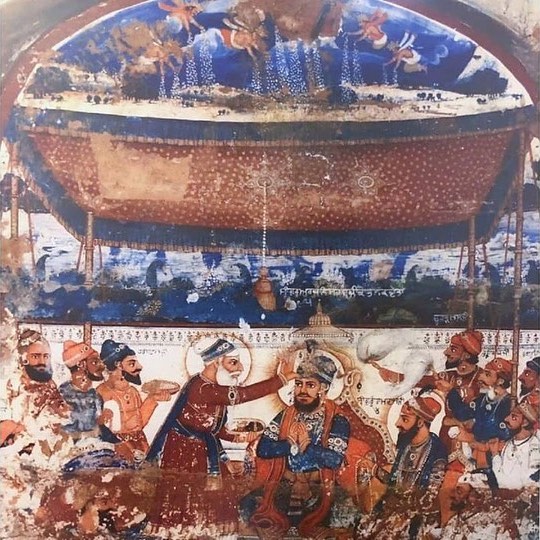|
Rehraas Sahib
Rehras Sahib (, pronunciation: , lit. “the way”), commonly known as So dar Rehras, is the daily evening prayer of the Sikhs and is part of Nitnem. It includes hymns from Guru Granth Sahib Ji and Dasam Granth Ji. It contains hymns of So Dar, So Purakh, Chaupai Sahib, a concise version of Anand Sahib, and Mundhavani, among which Chaupai Sahib is from the Dasam Granth Ji. This Bani is a collection of hymns of five Sikh Gurus: Guru Nanak Dev Ji, Guru Amar Das Ji, Guru Ram Das Ji, Guru Arjan Dev Ji and Guru Gobind Singh Ji. See also * Guru Granth Sahib * Dasam Granth The ( Gurmukhi: ਦਸਮ ਗ੍ਰੰਥ ''dasama gratha'') is a collection of various poetic compositions attributed to Guru Gobind Singh. References External links [...More Info...] [...Related Items...] OR: [Wikipedia] [Google] [Baidu] |
Prayer
File:Prayers-collage.png, 300px, alt=Collage of various religionists praying – Clickable Image, Collage of various religionists praying ''(Clickable image – use cursor to identify.)'' rect 0 0 1000 1000 Shinto festivalgoer praying in front of the Tagata fertility shrine rect 1000 0 2000 1000 Balinese Hindu bride praying during a traditional wedding ceremony rect 2000 0 3000 1000 Muslim pilgrim praying at the Masjid al-Haram rect 0 1000 1000 2000 Catholic Trappist monk praying before a crucifix rect 1000 1000 2000 2000 Ethiopian priest praying in Lalibela rect 2000 1000 3000 2000 Buddhists praying in Leh rect 0 2000 1000 3000 Sikh praying in Front of the Golden Temple in Amritsar rect 1000 2000 2000 3000 Members of the Mengjia Longshan Temple Association gather for a traditional Chinese prayer service rect 2000 2000 3000 3000 Jewish people praying at the Western Wall Prayer is an invocation or act that seeks to activate a rapport with an object of worship through d ... [...More Info...] [...Related Items...] OR: [Wikipedia] [Google] [Baidu] |
Sikhs
Sikhs (singular Sikh: or ; , ) are an ethnoreligious group who adhere to Sikhism, a religion that originated in the late 15th century in the Punjab region of the Indian subcontinent, based on the revelation of Guru Nanak. The term ''Sikh'' has its origin in the Sanskrit word ', meaning 'seeker', or . According to Article I of Chapter 1 of the Sikh Rehat Maryada, Sikh ''Rehat Maryada'' (), the definition of Sikh is: Any human being who faithfully believes in One Immortal Being Ten Gurus, from Guru Nanak Sahib to Guru Gobind Singh Sahib The Guru Granth Sahib The utterances and teachings of the ten Gurus and The initiation, known as the Amrit Sanskar, Amrit Sanchar, bequeathed by the tenth Guru and who does not owe allegiance to any other religion, is a Sikh. Male Sikhs generally have ''Singh'' () as their last name, though not all Singhs are necessarily Sikhs; likewise, female Sikhs have ''Kaur'' () as their last name. These unique last names were given by the Gurus to ... [...More Info...] [...Related Items...] OR: [Wikipedia] [Google] [Baidu] |
Nitnem
''Nitnem'' () is a collection of Sikh hymns ('' Gurbani'') to be read minimally 3 different times of the day. These are mandatory and to be read by every Amritdhari Sikh as expressed in the Sikh Rehat Maryada. Optionally additional prayers may be added to a Sikh's ''nitnem''. There are five hymns ''( Five Banis)'' to be done during '' Amrit Vela'' (early morning), the '' Rehras Sahib'' hymn for the evening and '' Kirtan Sohila'' for the night. The morning and evening prayers should be followed by an '' Ardaas''. Five ''Banis'' The initiated Sikh is asked by the Panj Piare during the Amrit Sanchar ceremony to recite the following five banis () as a commitment to the Sikh Gurus and Waheguru. The ''banis'' are also recited daily, starting in the early morning ( Amrit Vela). Through time, the "five banis" has come to mean different things to different groups of Sikhs. Morning prayers * Japji Sahib * Jaap Sahib * Tav-Prasad Savaiye * Chaupai Sahib * Anand Sahib As per ... [...More Info...] [...Related Items...] OR: [Wikipedia] [Google] [Baidu] |
Guru Granth Sahib
The Guru Granth Sahib (, ) is the central holy religious scripture of Sikhism, regarded by Sikhs as the final, sovereign and eternal Guru following the lineage of the ten human gurus of the religion. The Adi Granth (), its first rendition, was compiled by the fifth guru, Guru Arjan (1564–1606). Its compilation was completed on 29 August 1604 and first installed inside the Golden Temple in Amritsar on 1 September 1604. Baba Buddha was appointed the first Granthi of the Golden Temple. Shortly afterwards Guru Hargobind added Ramkali Ki Vaar. Later, Guru Gobind Singh, the tenth Sikh guru, added hymns of Guru Tegh Bahadur to the Adi Granth and affirmed the text as his successor. This second rendition became known as the Guru Granth Sahib and is also sometimes referred to as the Adi Granth.Adi Granth Encyclopaedia Brit ... [...More Info...] [...Related Items...] OR: [Wikipedia] [Google] [Baidu] |
Dasam Granth
The ( Gurmukhi: ਦਸਮ ਗ੍ਰੰਥ ''dasama gratha'') is a collection of various poetic compositions attributed to Guru Gobind Singh.Dasam Granth Encyclopædia Britannica, pages 2, 67 The text previously enjoyed an equal status with the Adi Granth, or Guru Granth Sahib, in the eighteenth and nineteenth centuries and were installed side by side on the same platform. The ''Dasam Granth'' lost favor during the colonial period when reformist Singh Sabha Movement scholars couldn't contextualize the reworkings of Puranic stories or the vast collection of 'Tale ... [...More Info...] [...Related Items...] OR: [Wikipedia] [Google] [Baidu] |
Chaupai (Sikhism)
Kaviyo Bach Benti Chaupai (also referred to as Chaupai Sahib or simply as Benti Chaupai) (Gurmukhi: ਕਬਿਯੋਬਾਚ ਬੇਨਤੀ ਚੌਪਈ or ਚੌਪਈ ਸਾਹਿਬ) is a hymn by Guru Gobind Singh. Chaupai is the 405th ''Charitar'' of the Charitropakhyan composition contained within the Dasam Granth. It forms part of a Sikh's Nitnem (daily scripture reading) and is read during Amrit Sanchar ceremonies. Synopsis Chaupai Sahib is an extension of the 405th charitar, where two massive battles, including the latter between "Mahakal" and various demons, is narrated, as well as the struggle of the goddess that was born as a result of the first battle, and her quest for the acceptance of the Supreme Being, by her abandoning all other worldly desires, is illustrated. Structure Benti Chaupai consists of three parts: Kabiyo Bach Benti Chaupai, Arril, Chaupai, Savaiye, and Dohra. Kabiyo Bach Benti Chaupai is normally referred to as Chaupai in short. The Savai ... [...More Info...] [...Related Items...] OR: [Wikipedia] [Google] [Baidu] |
Anand Sahib
Anand Sahib (Gurmukhi: ਅਨੰਦ ਸਾਹਿਬ ''anada sāhiba'') is a collection of hymns in Sikhism, written in the Ramkali Raag by Guru Amar Das, the third Guru of the Sikhs. It appears on pages 917 to 922 in Guru Granth Sahib Ji. The word Anand means complete happiness. Synopsis The Anand Sahib is a part of the Nitnem (daily prayers) which are read by Amritdhari Sikhs before dawn. Anand Sahib is chanted at all the religious ceremonies of the Sikhs irrespective of the nature of the event. There are two versions of Anand Sahib: one which extends 40 pauries and one shorter version often called Chhota Anand Sahib which comprises the first five pauries and then skips to the last one. This shorter version of Anand Sahib is usually recited at the closing ceremonies before Ardas. The Chhota Anand Sahib is included at the end of Rehras Sahib. Anand Sahib, alongside ''Panj Granthi's'' (five chosen texts) Dakhni Oankar and Sidh Gosht are written in Raga Ramkali—the Raga ... [...More Info...] [...Related Items...] OR: [Wikipedia] [Google] [Baidu] |
Sikh Gurus
The Sikh gurus (Punjabi language, Punjabi: ਸਿੱਖ ਗੁਰੂ; Hindi: सिख गुरु) are the spiritual masters of Sikhism, who established the religion over the course of about two and a half centuries, beginning in 1469. The year 1469 marks the birth of Guru Nanak, the founder of Sikhism. Nine other human gurus succeeded him until, in 1708, the ''Guru Gaddi, Guruship'' was finally passed on by the tenth guru to the holy Sikhism, Sikh scripture, Guru Granth Sahib, which is now considered the living Guru by the followers of the Sikh faith. The guruship was also passed onto the ''Guru Panth'', consisting of the Khalsa; however, this form of guruship went into decline following to rise of Ranjit Singh. Etymology and definition ''Guru'' (, ; , Punjabi language, Punjabi: ਗੁਰੂ, International Alphabet of Sanskrit Transliteration, IAST: ''guru'') is a Sanskrit term for a "teacher, guide, expert, or master" of certain knowledge or field. Bhai Vir Singh (writer), V ... [...More Info...] [...Related Items...] OR: [Wikipedia] [Google] [Baidu] |
Guru Nanak Dev Ji
Gurū Nānak (15 April 1469 – 22 September 1539; Gurmukhi: ਗੁਰੂ ਨਾਨਕ; pronunciation: , ), also known as ('Father Nanak'), was an Indian spiritual teacher, mystic and poet, who is regarded as the founder of Sikhism and is the first of the ten Sikh Gurus. Nanak is said to have travelled far and wide across Asia teaching people the message of '' Ik Onkar'' (), who dwells in every one of his creations and constitutes the eternal Truth. With this concept, he would set up a unique spiritual, social, and political platform based on equality, fraternal love, goodness, and virtue. Nanak's words are registered in the form of 974 poetic hymns, or ''shabda'', in the holy religious scripture of Sikhism, the Guru Granth Sahib, with some of the major prayers being the '' Japji Sahib'' (; ''ji'' and ''sahib'' are suffixes signifying respect); the '' Asa di Var'' ('Ballad of Hope'); and the '' Sidh Gosht'' ('Discussion with the Siddhas'). It is part of Sikh religious beli ... [...More Info...] [...Related Items...] OR: [Wikipedia] [Google] [Baidu] |
Guru Amar Das Ji
Guru Amar Das (Gurmukhi: ਗੁਰੂ ਅਮਰ ਦਾਸ, pronunciation: ; 5 May 1479 – 1 September 1574), sometimes spelled as Guru Amardas, was the third of the Ten Gurus of Sikhism and became Sikh Guru on 26 March 1552 at age 73. Before becoming a Sikh (Shishya from Sanskrit), on a pilgrimage after having been prompted to search for a ''guru'', he heard his nephew's wife, Bibi Amro, reciting a hymn by Guru Nanak, and was deeply moved by it. Amro was the daughter of Guru Angad, the second Guru of the Sikhs. Amar Das persuaded Amro to introduce him to her father. In 1539, Amar Das, at the age of sixty, met Guru Angad and became a Sikh, devoting himself to the Guru. In 1552, before his death, Guru Angad appointed Amar Das as the third Guru of Sikhism. Guru Amar Das was an important innovator in the teachings of Guru who introduced a religious organization called the Manji system by appointing trained clergy, a system that expanded and survives into the contemporary era. ... [...More Info...] [...Related Items...] OR: [Wikipedia] [Google] [Baidu] |
Guru Ram Das
Guru Ram Das (Gurmukhi: ਗੁਰੂ ਰਾਮ ਦਾਸ, pronunciation: ; 24 September 1534 – 1 September 1581), sometimes spelled as Guru Ramdas, was the fourth of the ten Sikh gurus. He was born to a family based in Lahore, who named him Bhai Jetha. He was orphaned at age seven; and thereafter grew up with his maternal grandmother in a village. At age 12, Bhai Jetha and his grandmother moved to Goindwal, Goindval, where they met Guru Amar Das, the third leader of Sikhism. The boy accepted the guru as his mentor, served him, and eventually joined his family by marrying his daughter. When it came time for Guru Amar Das to name his successor, he passed over his own sons and chose Bhai Jetha, citing his exemplary service, selfless devotion, and unquestioning obedience. Renamed Ram Das ("slave of God"), Bhai Jetha became the fourth Guru of Sikhism in 1574. He faced hostility from the sons of Guru Amar Das, and shifted his official base to lands identified by Guru Ama ... [...More Info...] [...Related Items...] OR: [Wikipedia] [Google] [Baidu] |
Guru Arjan Dev
Guru Arjan (Gurmukhi: ਗੁਰੂ ਅਰਜਨ, pronunciation: ; 15 April 1563 – 30 May 1606) was the fifth of the ten total Sikh Gurus. He compiled the first official edition of the Sikh scripture called the Adi Granth, which later expanded into the Guru Granth Sahib. He is regarded as the first of the two Gurus martyred in the Sikh faith. Guru Arjan was born in Goindval, in the Punjab, the youngest son of Bhai Jetha, who later became Guru Ram Das, and Mata Bhani, the daughter of Guru Amar Das. He completed the construction of the Darbar Sahib at Amritsar, after the fourth Sikh Guru founded the town and built a sarovar. Arjan compiled the hymns of previous Gurus and of other saints into Adi Granth, the first edition of the Sikh scripture, and installed it in the Harimandir Sahib. Guru Arjan reorganized the masand system initiated by Guru Ram Das, by suggesting that the Sikhs donate, if possible, one-tenth of their income, goods or service to the Sikh organization (''d ... [...More Info...] [...Related Items...] OR: [Wikipedia] [Google] [Baidu] |








